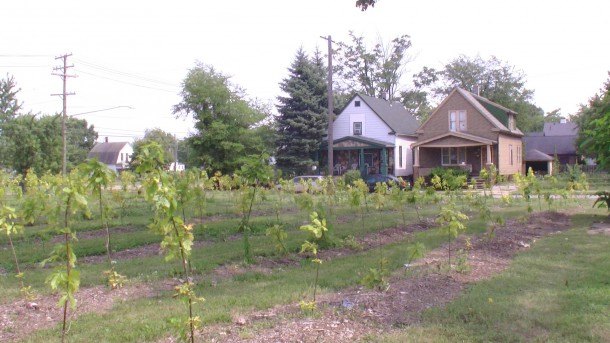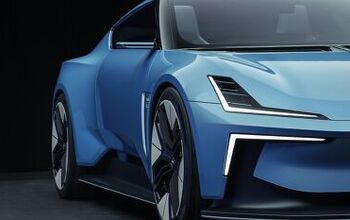Forward Into the Past: Ronnie's Favorites From 2015

As we enter 2016, the management here at TTAC has asked the staff writers to come up with summaries of our contributions to the site in 2015. Mark Stevenson gave us a pretty wide latitude, suggesting we could reference both posts that got lots of eyeballs and clicks and stories that didn’t get the attention we’d have preferred.
Before I get to my favorite posts of 2015, however, I need to get something off of my chest.
This may come as a shock to those who toss the “clickbait” accusation at a clever headline, but we don’t write this stuff just for our personal gratification and financial remuneration. We’d also kind of prefer that folks gather around our soapbox and bend an ear to hear our shpiel. Sometimes, though, we put a lot of effort into something, but the planets don’t align and relatively few people read it.
There was a recent post of mine about a Texas plumber suing a dealer who took his Ford Super Duty pickup truck as a trade-in on a new work truck. The dealer neglected to remove the plumber’s advertising decals and the truck got shipped overseas where it ended up on the front lines, publicized on social media, with some jihadis in Syria.
Around the same time, I posted a two– part series about Bonneville Salt Flat promoter and speed record holder Ab Jenkins and his record setting Duesenberg named the Mormon Meteor. In one of those serendipitous occurrences, while I was searching for info on the car, I came across the finding aid for a personal collection of J. Herbert Newport, who designed the Meteor’s body. The collection, which included Newport’s own original drawings of the car, happened to be at one of the University of Michigan’s libraries, about 45 minutes from my home. Now, to be honest, the Meteor piece was already long enough to split in two. I doubt very much that any of the readers would have found the piece lacking without images of those drawings, but Leonard Schreiber, DVM, taught me that I had to do the best job I could, no matter the job, so I made the drive.
Putting aside the hours of research and writing involved in the Jenkins series (including a trip to Auburn, Indiana, where I photographed the Meteor), I undoubtedly spent more time driving to and from Ann Arbor and photographing those artifacts than I did working on the entire plumbing-truck-gone-jihad post. Combined, though, the two posts on Jenkins on his Duesenberg ended up getting a fraction of the readers of the jihadi truck post — which ended up being the most read post on the site that week by a large margin.
I’d be lying to say that I wasn’t happy about a successful post that got a lot of traffic, but it’d have been nice if all that traffic was for something about which I genuinely cared.
As a result, some of my choices below are indeed posts that I think deserve more readers than they got the first time around. Some, but not all. The rest I picked by what struck my fancy. I was going to just pick a single post from each month, but since I’m making the rules, there are a few more than twelve.
From January, I picked a post about a couple of red sports cars I found parked next to each other. “ If You Could Choose Only One: Ferrari 430 or Acura NSX?” asks a hard question of knowledgeable car enthusiasts (and this post gives me the opportunity to go back and make some corrections).
At the Detroit and Chicago auto shows, a number of manufacturers brought out vintage models to show their histories. “ Heritage Cuts Both Ways” suggests that the new model a car company introduces can sometimes be overshadowed by that history.
A news blog post, “ Skeptical Environmentalist Bjørn Lomborg Says Electric Cars Kill More Than ICEs,” about maverick environmentalist Bjørn Lomborg’s provocative suggestion that internal combustion engines created fewer health issues than EVs really stirred up a hornet’s nest among our readers. I think that’s the first time one of my posts got over 300 comments.
At the New York Auto Show in April, just before introducing the new CT6 flagship sedan, Cadillac boss Johan de Nysschen had a few spare moments in between on-air interviews and graciously recorded a personal greeting to TTAC’s perpetual Cadillac gadfly, Deadweight.
A while back, I stumbled on the fact that people — even car enthusiasts — prefer to read about people rather than machines. In May, I ran a story, “ Brotherly Love… For Crosleys,” that was nominally about the little Crosley car, but was actually about the Kaczmar brothers.
June was originally planned to be TV car month, with a trilogy on the Batmobile from the 1960s Batman series, the Monkeemobile from The Monkees, and an authentic Dukes of Hazzard “General Lee” Dodge Charger.
However, after I tried to determine whether a displayed Batmobile was the star car or one of George Barris’ authorized replicas used promotionally by the studio in “ A Real Batmobile Replica“, and found out that a scale model company recycled the Monkeemobile as The Fonz’s Dream Rod during Happy Days run in “ Hey, Hey, It’s the Fonz Dream Rod Monkeemobile,” some racist lunatic (but I repeat myself) shot up a black church in Charleston and, subsequently, the Confederate battle flag on top of General Lee became problematic — so we discussed that in “ How Do You Feel About The General Lee’s Confederate Flag?”
Sam Sandifer collects the scale models created in automotive styling studios. One of the prizes of his collection is the 1:10 model of the original Lincoln Continental that sat on Edsel Ford’s desk. That model was recovered from storage by FoMoCo clay modeler Larry Wilson. “ ‘I’m Here to See Mr. Ford’ – A Detroit Story” tells how Wilson, as a very young man, traveled to Dearborn to work designing cars and ended up being hired by Henry Ford himself.
TTAC gives us a lot of leeway when it comes to subject matter. What happens in the City of Detroit often impacts the auto industry, even if it isn’t directly related to cars.
There has been no shortage of punditry drawing links between the rocky fortunes of the domestic auto industry over the past four decades and the decline and decay of the Motor City. As a long time area resident and someone who’s in the city on an almost daily basis, I’m confident in saying that Detroit has finally bottomed out and there are tendrils of revitalization. That botanical reference is deliberate. “ Hantz Woodlands – A Tree Grows (Actually It’s More Like 20,000) In Detroit” tells of my visit to financier John Hantz’s urban tree farm that is stabilizing a salvageable residential neighborhood by planting hardwood trees in empty lots on the city’s far east side, improving the quality of life for those who live there.
There were a couple of other posts in August I’d like to highlight. “ Nothing Arrives in Style Like a Dual Cowl Phaeton” presents my thesis that prewar, classic, dual-cowl cars — from companies like Packard, Duesenberg and Lincoln — make a style statement like no other automobile. To honor some of the designers whose talents brought cars like those to reality, “ Designers and Their Cars – Automotive Patent Art Revisited” reviews the impressive art that accompanies the design patents filed by notable car stylists.
September presented a news item similar to the jihadi plumbing truck — something more humorous than historical — and then serendipity happened and a natural follow-up story presented itself.
First, in “ Along Came A Spider… Child Injured In Collision With School Bus When Arachnophobic Mom Flees Car In Gear,” an Indiana boy was injured in a collision with a school bus when his mother, frightened by a spider in the car, bolted from her Dodge Avenger with the car still in reverse and her son still in the back seat. Then, just days later in “ Arachnophobia – The Sequel; Michigan Motorist Sees Spider, Sets Car & Gas Pump On Fire,” another arachnophobe, this one a Detroit area motorist, almost started a conflagration at a gas station when he used his cigarette lighter to try and kill a spider that had landed on the gasoline filler neck of his car — while he was still refueling the car.
October brought us “ Larry LaBute’s Wheelchair Accessible Lincoln Zephyr and Bentley Mk VI Restomods,” the inspirational story of Larry LaBute: a paraplegic tomato farmer from Ontario, who has considerably re-engineered his two vintage cars so he can operate them from his wheelchair. It annoys me that people will scroll past a story like this — that our managing editor and I think is appealing from a variety of perspectives — and instead read about drivers afraid of spiders. LaBute did a remarkable job. Despite the considerable modifications, including a front-wheel-drive conversion to create enough space for his chair and a hydraulic ramp/lift, the cars appear normal when going down the road.
Also inspirational is the story of Clessie Cummins. Cummins is a familiar brand in the automotive and trucking world, but less familiar is the story of the man behind the brand. Cummins didn’t have to deal with a physical disability. However, to create the first practical diesel truck engines, he designed, built, and tested about 3,000 prototypes before coming up with a direct fuel injection system capable of delivering a precise amount of fuel at exactly the right time. In “ Clessie Cummins Made Diesels the King of the Road … and Almost at Indy Too. Part One,” I went over Clessie’s biography, how he perfected diesel engines and worked hard to get them accepted by the trucking industry. In “ Clessie Cummins Made Diesels the King of the Road… and Almost at Indy Too. Part Two,” I covered Cummins’ personal involvement with the 500 mile race at Indianapolis Motor Speedway. Clessie had a lifelong love affair with the greatest spectacle in racing. He was part of the pit crew for Ray Harroun’s Marmon Wasp that won the first Indy 500 in 1911 and he later entered a series of diesel-powered cars, including the 1952 Cummins Diesel Special that started the race from pole.
Another two-parter was the aforementioned series about speed record holder and Bonneville Salt Flat promoter Ab Jenkins and his Mormon Meteor endurance and speed record Duesenberg, “ Ab Jenkins and His Mormon Meteor, Part One” and “ Ab Jenkins and His Mormon Meteor, Part Two (With Designer’s Original Drawings).” To be honest, I didn’t drive up to Ann Arbor just because my father taught me that I have to do a good job. I get a kick out of seeing and handling original historical documents. I’ve written about the notebooks that Fred Haynes and John Dodge kept while the Dodge brothers planned the startup of their eponymous car company from 1912-1914 and I put online a digital facsimile of the correspondence course of the Ur-father of automotive styling, Andrew F. Johnson. Once I found out that Herb Newport’s own drawing of the Meteor was nearby, I had to see it with my own eyes.
Corradino D’Ascanio spent most of his career designing aircraft for Piaggio, a diversified Italian manufacturer, yet his best known and most enduring design was earthbound: the Vespa scooter. Piaggio also briefly made a tiny Vespa car, also designed by D’Ascanio, one of a number of microcars that went on sale in postwar Europe. Compared to most of those, the 1958 Vespa 400 was pretty sophisticated, with some interesting technical features, but it came to market just as a number of larger, faster, and more practical sub-compact cars like the BMC Mini and Fiat 500 went on sale. If you’re into two-wheelers, “ I Bet You Thought Vespa Only Made Scooters: The Vespa 400 Car” has plenty of Vespa history in addition to the Vespa car’s story.
So that’s 2015.
The whiteboard on the wall still has a long list of interesting and or significant motor vehicles that I’ve photographed but not gotten around to writing posts about yet. That list includes: Cars with faux wood, Lincoln Mk IV, Sterling/Sebring kit car, Rolls-Royce Camargue, a survivor Jaguar XK-120, GMC Motorhome, Canadian Acadians, Australian Chrysler Charger, Fox-body Mercury Capri, Brooks Steven’s Jeep Jeepster, Continental Mk II, Fruehauf trailers, one-owner 400,000 1964 Pontiac GTO, Mike Kleeves: Master Metal Shaper, that hideous V-12-powered Packard revival concept, Kaiser Darrin, cars from the Auburn, Cord, Duesenberg Festival, the Duesenberg Thunder Run (drag racing Dueseys), the ridiculously unsafe Subaru 360 that Malcolm Bricklin imported, King Midget, Buick Reatta, TVR, neoclassics (like the Excalibur), Bruce Mohs and his amazing and weird cars, Chip Foose restomodded Bob Hope Imperial Ghia limo, carved panel hearses, and the last Panhard car.
Let me know in the comments if you have a particular interest in any of those topics.
Ronnie Schreiber edits Cars In Depth, a realistic perspective on cars & car culture and the original 3D car site. If you found this post worthwhile, you can get a parallax view at Cars In Depth. If the 3D thing freaks you out, don’t worry, all the photo and video players in use at the site have mono options. Thanks for reading – RJS

Ronnie Schreiber edits Cars In Depth, the original 3D car site.
More by Ronnie Schreiber
Latest Car Reviews
Read moreLatest Product Reviews
Read moreRecent Comments
- Theflyersfan I used to love the 7-series. One of those aspirational luxury cars. And then I parked right next to one of the new ones just over the weekend. And that love went away. Honestly, if this is what the Chinese market thinks is luxury, let them have it. Because, and I'll be reserved here, this is one butt-ugly, mutha f'n, unholy trainwreck of a design. There has to be an excellent car under all of the grotesque and overdone bodywork. What were they thinking? Luxury is a feeling. It's the soft leather seats. It's the solid door thunk. It's groundbreaking engineering (that hopefully holds up.) It's a presence that oozes "I have arrived," not screaming "LOOK AT ME EVERYONE!!!" The latter is the yahoo who just won $1,000,000 off of a scratch-off and blows it on extra chrome and a dozen light bars on a new F150. It isn't six feet of screens, a dozen suspension settings that don't feel right, and no steering feel. It also isn't a design that is going to be so dated looking in five years that no one is going to want to touch it. Didn't BMW learn anything from the Bangle-butt backlash of 2002?
- Theflyersfan Honda, Toyota, Nissan, Hyundai, and Kia still don't seem to have a problem moving sedans off of the lot. I also see more than a few new 3-series, C-classes and A4s as well showing the Germans can sell the expensive ones. Sales might be down compared to 10-15 years ago, but hundreds of thousands of sales in the US alone isn't anything to sneeze at. What we've had is the thinning of the herd. The crap sedans have exited stage left. And GM has let the Malibu sit and rot on the vine for so long that this was bound to happen. And it bears repeating - auto trends go in cycles. Many times the cars purchased by the next generation aren't the ones their parents and grandparents bought. Who's to say that in 10 years, CUVs are going to be seen at that generation's minivans and no one wants to touch them? The Japanese and Koreans will welcome those buyers back to their full lineups while GM, Ford, and whatever remains of what was Chrysler/Dodge will be back in front of Congress pleading poverty.
- Corey Lewis It's not competitive against others in the class, as my review discussed. https://www.thetruthaboutcars.com/cars/chevrolet/rental-review-the-2023-chevrolet-malibu-last-domestic-midsize-standing-44502760
- Turbo Is Black Magic My wife had one of these back in 06, did a ton of work to it… supercharger, full exhaust, full suspension.. it was a blast to drive even though it was still hilariously slow. Great for drive in nights, open the hatch fold the seats flat and just relax.Also this thing is a great example of how far we have come in crash safety even since just 2005… go look at these old crash tests now and I cringe at what a modern electric tank would do to this thing.
- MaintenanceCosts Whenever the topic of the xB comes up…Me: "The style is fun. The combination of the box shape and the aggressive detailing is very JDM."Wife: "Those are ghetto."Me: "They're smaller than a Corolla outside and have the space of a RAV4 inside."Wife: "Those are ghetto."Me: "They're kind of fun to drive with a stick."Wife: "Those are ghetto."It's one of a few cars (including its fellow box, the Ford Flex) on which we will just never see eye to eye.















































Comments
Join the conversation
Love your articles. Don't like commenting very much. Happy that TTAC allows one to lurk without commenting. I follow your articles and appreciate the work you put into them. Keep it up.
I'm glad to see this list as my TTAC reading is sporadic, and I have only enjoyed some of the articles thus far, in particular those on Ab Jenkins. I gather you must have found a Chrysler Charger in or around Michigan, not many over there. I met one of the design team a while back, also wrote about Australian Variants on Curbside Classic so if you have any questions or need any photographs I will help if I can.